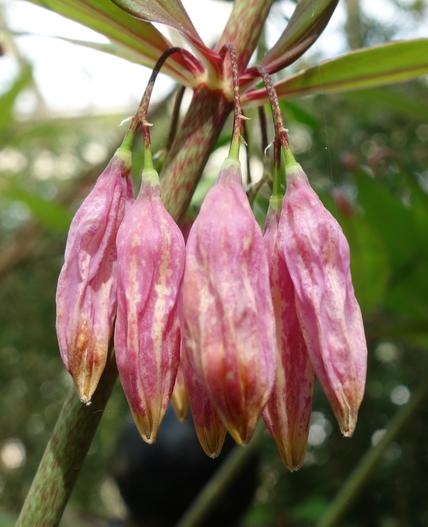Orange Solomon’s Seal
(Polygonatum kingianum)
Orange Solomon’s Seal (Polygonatum kingianum)
/
/

Daderot
CC0
Image By:
Daderot
Recorded By:
Copyright:
CC0
Copyright Notice:
Photo by: Daderot | License Type: CC0 | License URL: http://creativecommons.org/publicdomain/zero/1.0/deed.en | Uploader: Daderot | Publisher: Wikipedia Commons

Estimated Native Range
Summary
Polygonatum kingianum, commonly known as Orange Solomon’s Seal, is a deciduous perennial herb, native to forest margins, slopes, and shaded stream banks in Southeast Asia. It typically grows to a height of 4-5 feet (1.2-1.5 meters) and a width of 5-8 feet (1.5-2.4 meters), with arching stems that add a graceful appearance to garden settings. The plant features tubular orange flowers that hang in pairs or small clusters from the leaf axils in spring and early summer, providing a showy display that can attract pollinators such as bees.
Orange Solomon’s Seal is valued for its attractive foliage and unique flowers, making it a desirable addition to woodland gardens, shaded borders, and naturalized areas. It is relatively low maintenance, requiring moist, well-drained soil rich in organic matter. While it prefers part shade, it can tolerate full sun if kept adequately watered. This plant is also used in traditional Chinese medicine. Gardeners should be aware that it can spread via rhizomes, potentially becoming aggressive in ideal growing conditions.CC BY-SA 4.0
Orange Solomon’s Seal is valued for its attractive foliage and unique flowers, making it a desirable addition to woodland gardens, shaded borders, and naturalized areas. It is relatively low maintenance, requiring moist, well-drained soil rich in organic matter. While it prefers part shade, it can tolerate full sun if kept adequately watered. This plant is also used in traditional Chinese medicine. Gardeners should be aware that it can spread via rhizomes, potentially becoming aggressive in ideal growing conditions.CC BY-SA 4.0
Plant Description
- Plant Type: Herb
- Height: 4-5 feet
- Width: 5-8 feet
- Growth Rate: Moderate
- Flower Color: Orange
- Flowering Season: Spring, Summer
- Leaf Retention: Deciduous
Growth Requirements
- Sun: Full Sun, Part Shade
- Water: Medium, High
- Drainage: Medium
Common Uses
Bee Garden, Bird Garden, Butterfly Garden, Deer Resistant, Hummingbird Garden, Low Maintenance, Rabbit Resistant, Showy Flowers
Natural Habitat
native to forest margins, slopes, and shaded stream banks in Southeast Asia
Other Names
Common Names: Dian Huang Jing
Scientific Names: , Polygonatum kingianum, Polygonatum huanum, Polygonatum agglutinatum, Polygonatum uncinatum, Polygonatum vietnamicum, Polygonatum kingianum var. uncinatum, Galium tuberosum, Polygonatum cavaleriei, Polygonatum darrisii
GBIF Accepted Name: Polygonatum kingianum Collett & Hemsl.